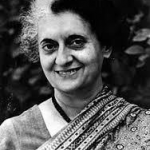Indira Gandhi

(19 Nov 1917- 31 Oct 1984)
“Education is a liberating force, and in our age it is also democratizing force, cutting across the barriers of caste and class, smoothing out inequalities imposed by birth and other circumstances.”
Mission/Vision
Bringing “RTE Act” in to force by April 10,2010 government has dedicated 2.7% of its GDP to expand the infrastructure of primary education which resulted in an established school at miles’ distance to every child and have brought down teacher to taught ratio to 1: 25 which is even lower to that stipulated in “RTE Act” itself. For this, training and recruitment of the teacher and the staff
at the concerned level has been taken on a massive scale. All these efforts have brought primary education to almost every one’s door.
However, along with this heartening and exhilarating outcomes there have been something which is constantly daunting us- that is the quality of education provided. Since the government being the largest player in the primary education with 70% of children in its own school. only 25-27% of rural children and around 45-50% of urban children are in private school today. So the government has the largest pie as the responsibility to determine the quality of education at primary level. Although scenario may differ in magnitude state-wise but as an astonishing fact that it has been seen an alarming rate of siphoning of govt. school student in to the private schools. So Govt. schools today are on the verge of being considered for poor, underprivileged and destitute only, for the reason that poor cannot afford a good private school for his child’s schooling. Apart from this “Annual Status of Education Report” (ASER) 2011 has brought to the light that majority of the student in govt. primary school are not reaching at “class-age appropriate learning level” due abysmally “low learning outcome”. The reasons for this are many. These vagaries have further compounded and aggravated the problems of quality and management
Moreover, while the govt. schools are struggling with the quality of the education provided the private one’s who were claiming flagrantly to take care of quality education are shifting to purely “business models”. Being governed by hidden objective of profit they are becoming un-affordable day by day. As a consequence, in the prevailing situation the 70% of the population living with abject poverty in far-off villages is deprived of quality affordable education at primary level- the repercussions of which are of manifold. This in long term leads to socio-economic inequality, gender disparity, regional disparity and social divide which ultimately culminates in to corruption, crime and violence in our society. Being under constitutional obligation and “third largest” developing economy in the world India cannot afford to overlook this problem.
Regional Perspective
Being categorized as one of the “backward state” in the country in the context of socio-economic developmental scale. It really becomes hard in positioning ourselves on a global scale in the same context. Nevertheless, as far as education is concerned we (UP) are the one having “abysmally low literacy rate” with 67.68% against the national average of 74% as per “2011 census report”. And even further Gonda lies back at 58.71% against some better performing district with 80% in the same states. Not to surprise female literacy rate has always been and is below the level of men in the country. By ignoring the all other aspects of well-being, there hardly remains anything to comment on the “quality education” and the excellence if we considered necessary, in the state especially in the district. Education being in the concurrent list of constitution opens an opportunity to both center and states to do the needful if it deems fit. By the way, some previous joint efforts of both center and state have not yielded much except in the increased coverage of primary education. Mushrooming of “sub-standard educational institution” dwindling in the noble path if envisaged ever, have led to the competition probably in terms of profit but certainly not in quality. Nevertheless, some good but asymmetric private efforts have been taken to address the concern of quality albeit, it is functioning almost in a way where elite serves and elite receives – that is way beyond to the reach of the lower middle and underprivileged class. If such a status continues to be maintained, it would be hard enough to predict the day when this 70% of the
population will join the mainstream development of the country and of the world, that to when circumstances have arisen where education has assumed its full international character as never before and is demanding global standards as rattling cry. In the light where India stands to be world’s “third largest” (with some other report to be fourth) economy after the United States and the China such a deplorable situation really become difficult to digest.
It is therefore, presumable that such an asymmetry and dilapidation of education system warrants some serious attention of the society. We with some Scientist, Professors, Bureaucrats, and Advocates in national ranks aims to simply dress and put an underprivileged, poor child in a healthy and affordable school where he/she could grow to compete others. Although, this is a difficult dream to realize given the predicament of the situation but we are of hope that our sincere efforts and your generous and thoughtful cooperation will help us to realize it together. Since we are not any corporate, capitalist or rulers just a school maintained by a Trust so your kind consideration becomes indispensable to our success.
We, therefore, wish to appeal to come together to help clean the atmosphere to make it conducive where a poor farmer parents with his child as his only hope could grow and may come out of the vagaries of his life and could dream hitherto undreamed off.
Mr. LAHUR M. VERMA
Junior Research Fellow, PhD
Indian Institute of Technology Delhi
New Delhi-110016
